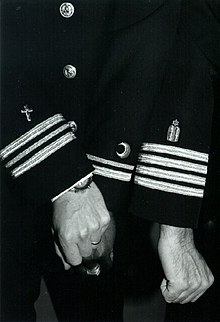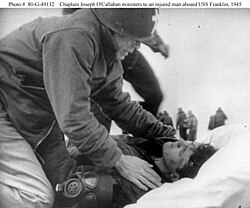
A chaplain is, traditionally, a cleric, or a lay representative of a religious tradition, attached to a secular institution, or a private chapel. The term chaplaincy refers to the chapel, facility or department in which one or more chaplains carry out their role.
The Archdiocese for the Military Services, USA is a Latin Church jurisdiction of the Catholic Church for men and women serving in the United States Armed Forces and their dependents.

A military chaplain ministers to military personnel and, in most cases, their families and civilians working for the military. In some cases, they will also work with local civilians within a military area of operations.
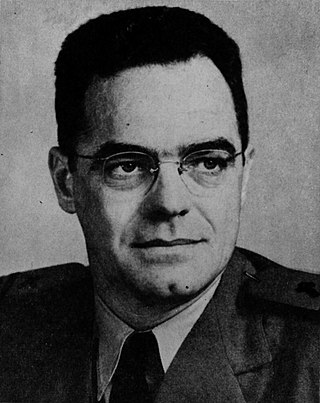
Joseph Timothy O'Callahan was a Jesuit priest and, during World War II, a United States Navy chaplain. He was awarded the U.S. military's highest decoration, the Medal of Honor, for his actions during and after an attack on the aircraft carrier aboard which he was serving, USS Franklin.

Vincent Robert Capodanno Jr., M.M. was a Catholic priest and Maryknoll Missioner killed in action while serving as a Navy chaplain with a Marine Corps infantry unit during the Vietnam War. He was a posthumous recipient of America's highest military decoration, the Medal of Honor, for heroic actions above and beyond the call of duty. The Catholic Church has declared him a Servant of God, the first of the four stages toward possible sainthood.

The United States Army Chaplain Corps (USACC) consists of ordained clergy of multiple faiths who are commissioned Army officers serving as military chaplains as well as enlisted soldiers who serve as assistants. Their purpose is to offer religious church services, counseling, and moral support to the armed forces, whether in peacetime or at war.
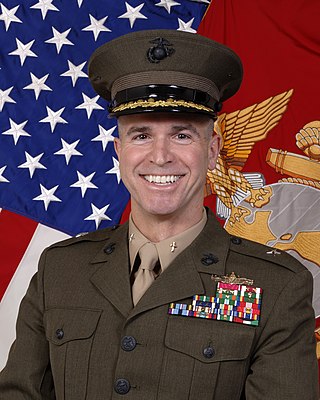
Rear Admiral Alan T. Baker, USN, is a retired American Navy officer who served as the 16th Chaplain of the United States Marine Corps from 2006 to 2009. Chaplain Baker was the first graduate of the United States Naval Academy and former Surface Warfare Officer to serve as a Chaplain Corps Flag Officer. Following his military career, Baker served as Directional Leader at Menlo Park Presbyterian Church, a 4,000-member, multi-campus church in the San Francisco Bay Area, from 2010 to 2012. He is currently principal of Strategic Foundations where he teaches, coaches and catalyzes organizations valuing the intersection of faith, learning and leadership.

Joseph Walter Estabrook was an American prelate of the Roman Catholic Church who served as an auxiliary bishop of the Archdiocese for the Military Services and also Titular Bishop of Flenucleta.

The Chaplain Corps of the United States Air Force (USAF) is composed of both clergy—commissioned officers who have been endorsed and ordained by a religious organization—and enlisted Religious Affairs. As military chaplains, their main purpose is to support the free exercise of religion by members of the military service, their dependents, and other authorized personnel. They also provide advice on spiritual, ethical, moral, and religious-accommodation issues to the leadership of the United States Department of Defense.

Arnold E. Resnicoff is an American Conservative rabbi who served as a military officer and military chaplain. He served in Vietnam and Europe before attending rabbinical school. He then served as a U.S. Navy Chaplain for almost 25 years. He promoted the creation of the Vietnam Veterans Memorial and delivered the closing prayer at its 1982 dedication. In 1984 the President of the United States spoke on his eyewitness account of the 1983 Beirut barracks bombing. After retiring from the military he was National Director of Interreligious Affairs for the American Jewish Committee and served as Special Assistant to the Secretary and Chief of Staff of the United States Air Force, serving at the equivalent military rank of Brigadier General.
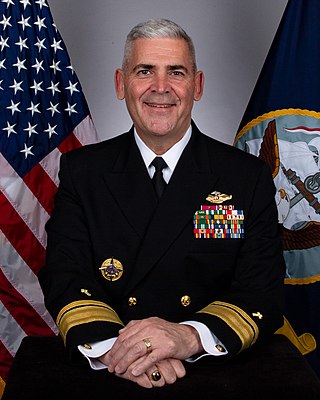
The Chief of Chaplains of the United States Navy (CHC) is the highest-ranking military chaplain in the United States Navy and head of the United States Navy Chaplain Corps. As part of the Office of the Chief of Naval Operations and Department of the Navy, the CHC is dual-hatted as the Director of Religious Ministries (N097) under OPNAV. In these capacities, the CHC is the principal advisor to the secretary of the Navy, the chief of naval operations and, where appropriate, the commandant of the Marine Corps and commandant of the Coast Guard "on all matters pertaining to religion within the Navy, United States Marine Corps, and United States Coast Guard." For administrative and personnel matters, the CHC reports to the chief of naval personnel.
In the United States armed forces, the Chiefs of Chaplains of the United States are the senior service chaplains who lead and represent the Chaplain Corps of the United States Army, Navy, and Air Force. The Navy created the first Office of the Chief of Chaplains in 1917; the Army followed in 1920, and the Air Force established its own in 1948 after it became a separate branch.

Margaret Grun Kibben is a U.S. Presbyterian minister who is the chaplain of the United States House of Representatives. She served as the 26th Chief of Chaplains of the United States Navy from 2014 to 2018; she was formerly the 18th Chaplain of the United States Marine Corps (CHMC) and the Deputy Chief of Chaplains of the United States Navy from 2010 to 2014. Kibben was the first woman to hold each of these positions.
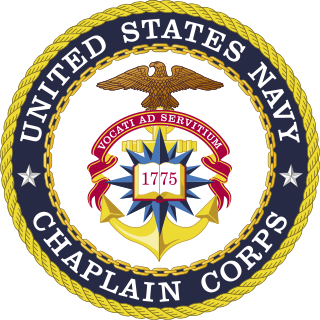
The Chaplain of the United States Marine Corps (CHMC) is a position always filled by the officers serving as Deputy Chief of Chaplains of the United States Navy as a "dual hatted" billet since 2000. The CHMC oversees religious ministry in the Marine Corps which one Commandant of the Marine Corps defined as "a vital function which enhances the personal, family, and community readiness of our Marines, sailors, and their families. Chaplaincy supports the foundational principle of free exercise of religion and helps to enrich the spiritual, moral and ethical fabric of the military."
John Francis "Jake" Laboon Jr. was an officer of the United States Navy, who served as a submariner in World War II and as a Roman Catholic chaplain in the Vietnam War.

Religious symbolism in the United States military includes the use of religious symbols for military chaplain insignia, uniforms, emblems, flags, and chapels; symbolic gestures, actions, and words used in military rituals and ceremonies; and religious symbols or designations used in areas such as headstones and markers in national cemeteries, and military ID tags.

The Armed Forces Chaplaincy Center (AFCC) was the center for training of United States military chaplains, located at Fort Jackson, Columbia, South Carolina. Co-located on the AFCC campus were: the United States Army Chaplain Center and School, the United States Naval Chaplaincy School and Center, and the United States Air Force Chaplain Corps College. The Center includes the "Joint Center of Excellence for Religious Training and Education."

United States military chaplains hold positions in the armed forces of the United States and are charged with conducting religious services and providing counseling for their adherents. As of 2011, there are about 2,900 chaplains in the Army, among the active duty, reserve, and National Guard components.

In addition to the three official Chaplain Corps seals for the army, navy, and air force, chaplaincies also have special seals and emblems for special schools and organizations for their chaplains, as well as a shared emblem for the "Armed Forces Chaplaincy Center" (AFCC), Fort Jackson, Columbia, South Carolina, where chaplains from all branches of the military receive their training. The original AFCC emblem had three symbols traditionally associated with learning and wisdom—a lamp, a torch and a book. A second emblem was developed by the Commandants and Commanding Officer of the three schools, in part so that it could be used on the reverse side of a two-sided AFCC challenge coin, with one symbol drawn from each of the army, navy, and Chaplain Corps emblems: a dove from the army emblem, cupped hands from the air force emblem, and an anchor from the navy emblem. In addition to using both emblems on the two sides of the AFCC coin, both designs were displayed in the AFCC lobby.

Gregory N. Todd is a United States Navy rear admiral and chaplain who serves as the 28th Chief of Chaplains of the United States Navy. He previously served as the 20th Chaplain of the Marine Corps. He also served for four years as the tenth Chaplain of the Coast Guard. Over a thirty-two year career, he has served in a variety of Navy, Marine Corps, and Coast Guard assignments, including deployments to Iraq and Afghanistan and chaplaincy work at Ground Zero in the wake of the September 11 attacks. He is a Lutheran.


